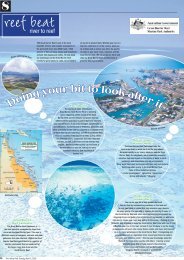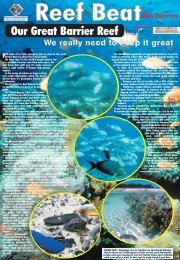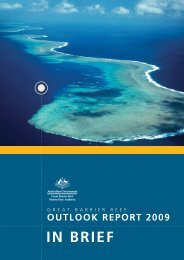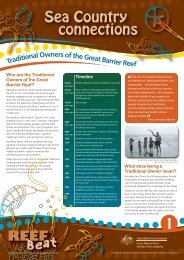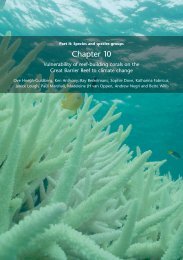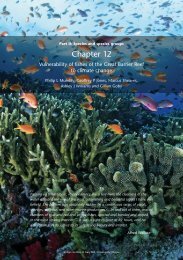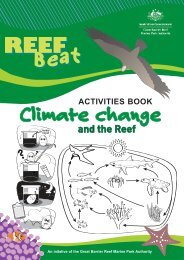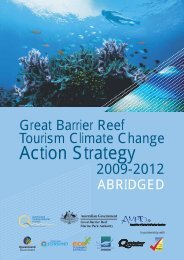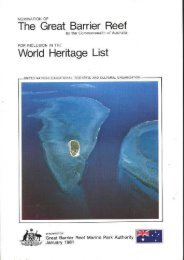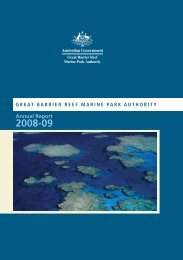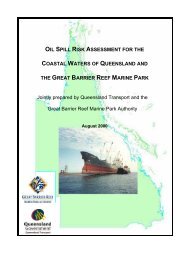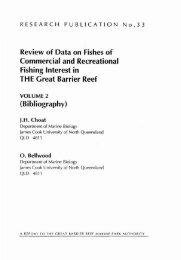Coral Bleaching Response Plan - Great Barrier Reef Marine Park ...
Coral Bleaching Response Plan - Great Barrier Reef Marine Park ...
Coral Bleaching Response Plan - Great Barrier Reef Marine Park ...
You also want an ePaper? Increase the reach of your titles
YUMPU automatically turns print PDFs into web optimized ePapers that Google loves.
<strong>Great</strong> <strong>Barrier</strong> <strong>Reef</strong> <strong>Coral</strong> <strong>Bleaching</strong> <strong>Response</strong> <strong>Plan</strong> 2005/2006<br />
3.2.2 Survey Sites<br />
Each survey will assess the condition and composition of the benthic community along five cross-shelf<br />
transects (Table 1 lists the reef sites for each of these transects). These will be located at latitudes<br />
centred on Lizard Island, Cairns, Townsville, Whitsunday Islands and the Capricorn Bunker Group.<br />
Forty five sites have been selected based on existing AIMS LTMP site locations, to provide for a longterm<br />
data set on coral cover and community composition at the sites. Three inshore, three mid-shelf and<br />
three outer shelf reefs have been selected for each transect. Sites were selected from the AIMS LTMP<br />
database based on the existence of previous coral bleaching survey data (1998 and 2002), accessibility<br />
under predominant weather conditions and location of <strong>Reef</strong> Water Quality Protection <strong>Plan</strong> 1 survey sites.<br />
The benefit of this approach is that baseline and recovery data for the deep transects can be obtained<br />
from the AIMS LTMP routine surveys and thus reduce the need for multiple GBRMPA survey trips and<br />
duplication with existing programmes. However, the LTMP only surveys the coral community on the<br />
lower reef slope (6-9 m) while the GBRMPA <strong>Response</strong> <strong>Plan</strong> also surveys the community on the upper<br />
slope (3-4 m), as this is the area most affected by coral bleaching. It is necessary to obtain a quantitative<br />
baseline assessment of the upper slope community at all of the survey sites to enable us to evaluate the<br />
long-term ecological impacts of coral bleaching on the <strong>Great</strong> <strong>Barrier</strong> <strong>Reef</strong>.<br />
Some remote locations along the GBR have been omitted from the standard sites selected, such as the<br />
northern Swains and Pompey Complex. These locations are rarely visited and do not have long-term<br />
datasets as they are not AIMS LTMP survey sites. If a significant bleaching event occurs, these sites<br />
will be surveyed if logistics allow.<br />
Additional sites may be surveyed using manta tow or rapid assessment techniques in a bleaching event.<br />
These sites would be selected to match those surveyed in the 1998 and 2002 bleaching events, reefs<br />
surveyed under the <strong>Reef</strong> <strong>Plan</strong> monitoring programme (e.g. Daydream Is, Dent Is and Double Cone Is),<br />
and other sites of interest. They will be surveyed as time and resources permit.<br />
3.2.3 Survey Design<br />
Three shelf positions will be surveyed in each transect: inshore, mid-shelf and outer shelf. Three<br />
replicate reefs will be surveyed at each shelf position. Sites will be those established by the AIMS<br />
LTMP and will be divided into 2 depth zones: shallow and deep. The shallow station includes the reef<br />
crest and upper slope from about 1 m – 4 m in depth. The deep station includes the mid to lower reef<br />
slope from 5 – 10 m. Actual depths at each station vary according to the reef morphology and coral<br />
community type and distribution. At more turbid stations, or areas with poorer reef development, these<br />
depths may be shallower, while at stations that are generally characterised by clear conditions they are<br />
deeper. In the few stations with very restricted reef development, only the shallow depth zone is<br />
present. These depth zones, once established, will be fixed for each station.<br />
Three random transects will be surveyed at each depth at each station. Random transects will be used<br />
rather than fixed transects to reduce time required for establishment and survey, avoid unsightly<br />
markers on the reef and ensure independence among consecutive surveys. Each transect will be<br />
surveyed simultaneously by two independent methods: a rapid visual assessment and video transects.<br />
Two divers will swim along a 50 m belt transect, one recording information on the Rapid Assessment<br />
Survey data sheet and the other recording the same substratum area with an underwater video camera.<br />
The rapid assessment survey will record observations on condition of corals and other benthos within a<br />
band 5 m wide along the length of the transect. Three sets of information will be recorded: station<br />
1 The <strong>Reef</strong> Water Quality Protection <strong>Plan</strong> is a joint Australian and Queensland Government initiative to ‘halt and<br />
reverse the decline in water quality entering the <strong>Reef</strong> within 10 years’. The <strong>Reef</strong> <strong>Plan</strong> has a number of actions for<br />
addressing declining water quality, including the implementation of a water quality and ecosystem health longterm<br />
monitoring program in the GBR lagoon.<br />
Climate Change <strong>Response</strong> Programme - GBRMPA 9



